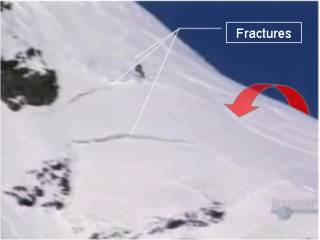This is a still from the above video showing the slope just as it starts to fracture. You can see existing tracks down the ridge but the skier is pushing just a bit further out onto steeper terrain which shows how even a few degrees extra can be critical. The wind probably loaded the ridge as shown by the red arrow and this extra soft powder is why they are sking this route.

The convex rollover would put stress on the snowpack as it stretches the snow. There is a fracture just above the skier but the two others form from the rocks on the left. These may have encouraged a temperature gradient in the snowpack and the formation of a weak layer of facetted snow and would also act as stress concentrators, helping fractures to form.

You can see that once the slide goes there is another rock just under the snowpack. The snowpack has broken right back to the ridge past where other skiers had descended. The funnel like shape and cliff is a terrain trap. Fortunately the amount of snow wasn’t large and the skier was highly skilled able to make the jump and ski out without a scratch. Don’t count on being so lucky.
